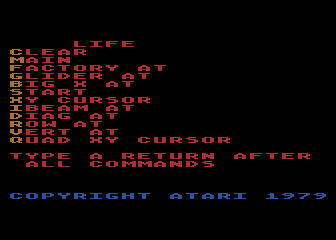Retro Replay Review
Gameplay
Video Easel delivers a uniquely creative experience by placing the power of generative art directly in the player’s hands. At its core, you begin by sketching a simple pattern or shape using an intuitive set of drawing tools. Whether you prefer freehand scribbles or geometric precision, the interface responds quickly to your strokes, allowing for quick experimentation and iteration.
(HEY YOU!! We hope you enjoy! We try not to run ads. So basically, this is a very expensive hobby running this site. Please consider joining us for updates, forums, and more. Network w/ us to make some cash or friends while retro gaming, and you can win some free retro games for posting. Okay, carry on 👍)
Once your initial design is complete, the real magic begins. The game’s AI harnesses the rules of Conway’s Game of Life to transform and build upon your creation. Every cell interacts with its neighbors according to simple survival and birth rules, leading to a mesmerizing cascade of evolving shapes. The process feels alive, as subtle changes in your original sketch can lead to wildly different visual outcomes over time.
The open-ended nature of Video Easel’s gameplay ensures virtually endless replayability. You can choose to let the simulation run indefinitely, marveling at the constantly shifting patterns, or reset at any point to craft a fresh canvas. This freedom encourages a cycle of creativity: draw, observe, reset, and reimagine.
Controls are straightforward and accessible to players of all skill levels. There are no complex menus or hidden mechanics—just your brush, a color palette, and the AI-driven sandbox. For those looking to unwind, the game doubles as a digital meditative tool, while creative enthusiasts will appreciate its unpredictable artistry and surprising depth.
Graphics
Visually, Video Easel captures the retro charm of early computing combined with the smooth elegance of modern generative art. The graphical output is crisp and fluid; patterns morph seamlessly from one form to another, creating a hypnotic, almost cinematic flow. Watching the screen evolve feels akin to viewing a dynamic screensaver but with a deeper, artistic purpose.
The color palette is deliberately simple yet effective. Bold primary hues contrast against dark backgrounds, emphasizing the shapes as they expand, contract, and dissolve. This minimalistic approach ensures that each new generation of patterns remains clear and striking, even as complexity piles on.
The reliance on Conway’s Game of Life gives Video Easel an inherently mathematical beauty. Cells appear, vanish, and stabilize in fascinating formations—blinkers, gliders, and oscillators come to life on your monitor. For fans of classic PC art and early digital experiments, this nod to pioneering computational graphics evokes a strong sense of nostalgia.
Overall, the graphics strike a careful balance between simplicity and sophistication. There’s enough visual variety to keep the eye engaged for hours, while the stripped-down aesthetic prevents sensory overload. It’s an ideal display of how elegant code and basic shapes can combine to produce endlessly captivating visuals.
Story
While Video Easel does not feature a traditional narrative or characters, it tells a different kind of story—one of emergence and transformation. Each session becomes a unique tale of patterns evolving in response to your original spark of creativity. The “plot” unfolds dynamically on-screen, driven by the rhythms of life and death rules in the cellular automaton.
The lack of a linear storyline is a deliberate design choice, reinforcing the game’s experimental ethos. Instead of following set chapters or missions, you become both author and observer of an ever-unfolding procedural drama. Your early doodles serve as the opening act, while the AI’s generative process writes the ensuing sequels in real time.
There is a subtle sense of progression as you tweak your designs to coax out desired behaviors: stable islands of cells, gliding formations, or pulsating clusters. In this way, the game builds an emergent narrative around discovery, experimentation, and the joy of witnessing complexity spring from simplicity.
For players who appreciate nontraditional storytelling, Video Easel offers a meditative, almost poetic journey. The “characters” are the cellular forms that dance across the grid, each new generation carrying echoes of the last. In this layered, evolving tapestry, you find a story without words—one written in pixels and code.
Overall Experience
Video Easel stands out as a creative playground rather than a conventional game. Its seamless blend of user-driven drawing and AI-led evolution delivers hours of exploratory fun. Whether you approach it as a stress-relief tool, an art experiment, or simply a mesmerizing visual diversion, the experience remains richly rewarding.
The game’s strengths lie in its elegant simplicity and boundless generative potential. There are no steep learning curves or mandatory objectives—only the invitation to create and observe. This makes Video Easel accessible to casual players seeking mellow entertainment as well as to digital artists hungry for inspiration.
Although lacking a narrative in the traditional sense, the title compensates by offering emergent storytelling and a deeply personal creative outlet. Each image you seed becomes wholly your own, yet evolves in unpredictable, often breathtaking ways. The result is a unique blend of control and surprise that keeps you coming back for more.
In summary, Video Easel is an engrossing addition to any creative or casual gaming library. It proves that simplicity in design can lead to profound outcomes, and that the intersection of art and computation remains fertile ground for innovation. For those intrigued by generative art or searching for a calming digital canvas, this game is well worth exploring.
 Retro Replay Retro Replay gaming reviews, news, emulation, geek stuff and more!
Retro Replay Retro Replay gaming reviews, news, emulation, geek stuff and more!








Reviews
There are no reviews yet.